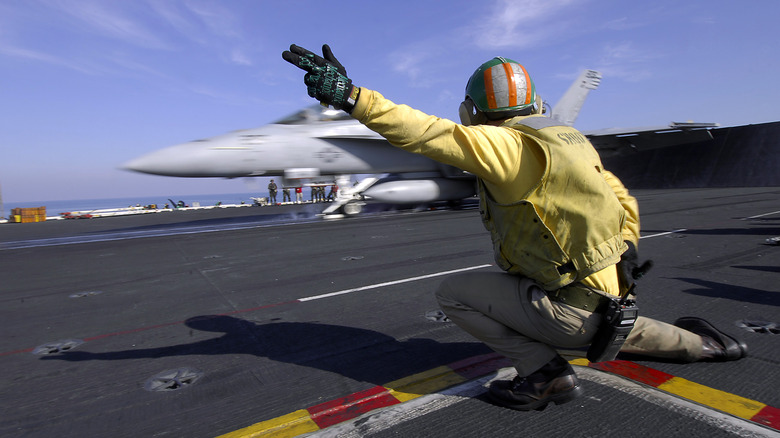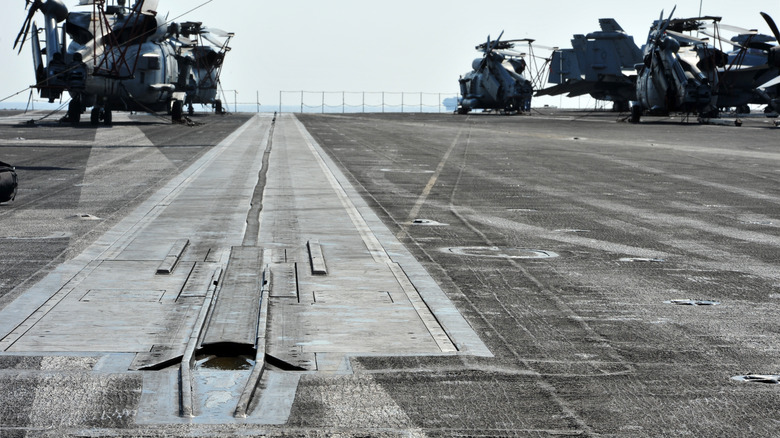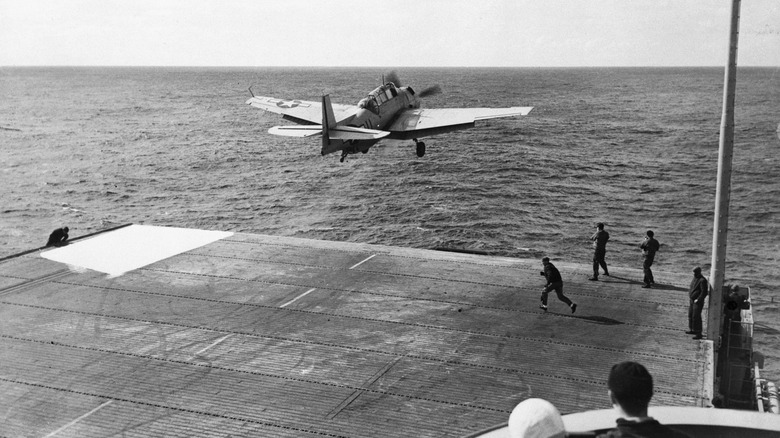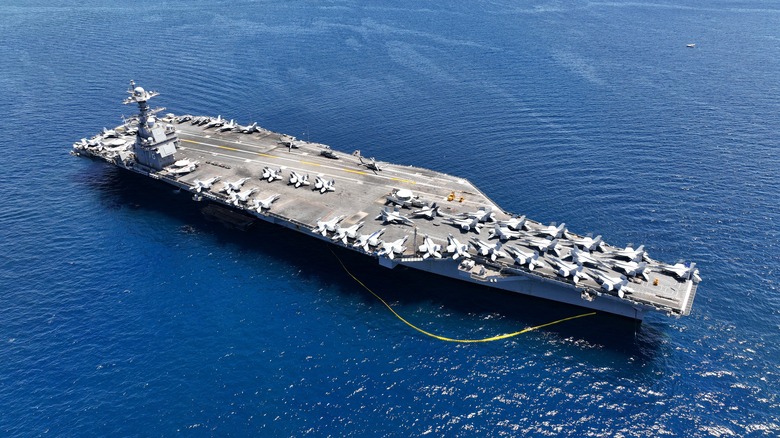Why Do Aircraft Carriers Have Catapults And How Do They Work?
Aircraft carriers are technological marvels. They're like small floating cities that can serve as a command center while hosting an entire fleet of aircraft. Carriers are essential when conducting military operations on other continents and have been a core part of most major world powers' fleets since before World War II. But even carriers have some limitations, and clever tech is required to work around those. One of the best examples is the aircraft carrier's catapult.
Catapults solve an obvious problem. If you've ever been to an airport, you may have noticed that runways are quite long. Aircraft carriers are among the largest vessels ever built, but even they can't compare to the length of a runway. The runway space on the deck of most carriers is just 300 feet long, with regular aircraft requiring around 2,000 feet more than that to comfortably reach takeoff speed.
Obviously, the fighter jets and bombers that take off from an aircraft carrier have far more thrust than your average plane, but that still isn't enough to get it up to speed in such a short distance. The catapult is in place to provide additional thrust, and a ramp at the end of the runway also helps get the plane airborne. When the plane is coming back to land, arresting gear and a device known as a tail hook does the opposite job of the catapult. It's designed to hook onto the back of the plane and help slow it down in an incredibly short distance.
The concept is fairly simple
The concept behind the naval catapult hasn't changed too much over the years. It's all pretty straightforward when you think about it, use something to add a lot of extra force to the aircraft's takeoff effort across a short distance. The basic components are the same too. A track is present on the deck of the carrier, and a "shuttle" is set on the track. A cable is hooked between the shuttle and the nose of the aircraft. Propulsion methods can vary, but something is used to propel the shuttle along the track at high speed, and the aircraft is then towed along behind it.
In terms of acceleration, things vary depending on the system and what they're dragging along, but all catapult launches are pretty fast. For example, a steam-powered catapult can take a jet from a standstill to 165 mph in around two seconds. That's around the same amount of time many of the world's fastest production cars take to reach 60 mph.
Once the plane is up to speed, the towing cable is released, and the aircraft continues on at that speed. You may be wondering what happens if something goes wrong. Maybe the catapult malfunctions, or the cable snaps, or it fails to release at the end of it all. If there is a problem, the pilot is supposed to eject and hope the ejector seat is enough to get them out of the situation. The plane will presumably carry on in the same direction and wind up in the sea.
Naval catapults have been around for a while
Although it may sound like a high-tech concept, the naval catapult has been around for about as long as planes have. The Wright Brothers first took to the skies in 1903, and the first successful naval catapult launch took place just over a decade later. In 1915, a compressed air-powered catapult managed to get a 1,700-pound seaplane up to 50 mph as it launched off the deck of the USS North Carolina.
The U.S. Navy didn't go all in on the aircraft catapult at that point, but it did have fully functional aircraft carriers by the start of World War II. The large and capable ships made a huge difference for the Allies during the conflict, with many speculating the war would have taken a different course if the United States' three Pacific Fleet aircraft carriers had been docked at the time of the Pearl Harbor attack. If they were present, there is a good chance that all three carriers would have been destroyed during the attack. With no U.S. aircraft carriers, the Pacific campaign may have played out very differently.
The first naval catapult used compressed air to launch the shuttle along the track, but many other propulsion methods have been tested and used throughout the years. These include catapults powered by gunpowder, hydraulic, weight and derrick, flywheel, and even solid fuel rocket boosters were used to get the shuttle moving.
Steam catapults are the most common, with the method first being pioneered by the British in the 1950s. They work by building up steam pressure in a reservoir which then drives a piston attached to the shuttle along at high speed. Steam catapults were capable of launching heavier post-war aircraft and were swiftly adopted by many navies with aircraft carriers. However, things may soon change as there is a newer propulsion method on the market.
Electromagnetism will propel aircraft in future
One of the more advanced forms of propulsion is electromagnetism-based. The system uses strong magnetic fields to move the shuttle and pull the aircraft along. So it's a bit like a rail gun with a wire attached to it. In terms of acceleration, the electromagnetic system has roughly the same speeds involved as its steam counterpart. It can get a plane to up to 150 miles per hour within 300 feet. It does have clear advantages in other departments, though, and that acceleration is a lot smoother, which should have less of an impact on those on board the aircraft.
Other major advantages that the electromagnetic system has over its steam-powered counterpart include its size. It's considerably smaller than its steam-based counterpart, so it saves room on the ship. Power levels can be adjusted more easily, which is handy given that not all aircraft weigh the same. The system won't have to wait to replenish its steam reservoir either, so it could launch around a third more aircraft per day, according to U.S. Navy's projections.
The catapults will be fitted to the United States Navy's Ford-class carriers. One is already present on the USS Gerald R. Ford, and the catapult for the USS John F. Kennedy is currently being tested. A minimum of four Ford-class carriers are being built, with some predictions putting the eventual number of the vessels at ten. The high-tech catapult will likely be used on Ford's successor, too, should aircraft carriers still be at the forefront of military strategy in a few decades.



